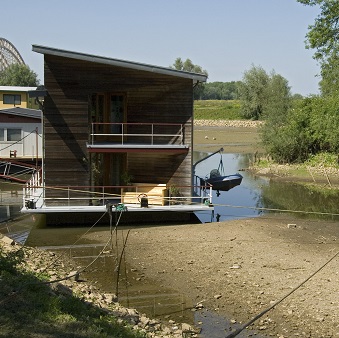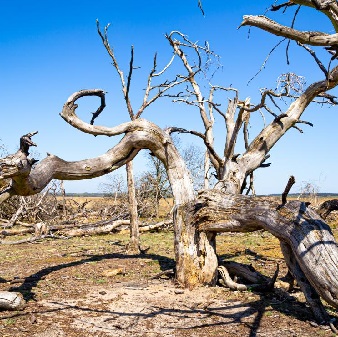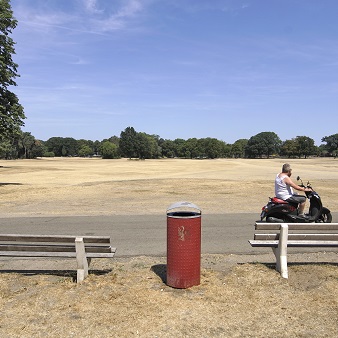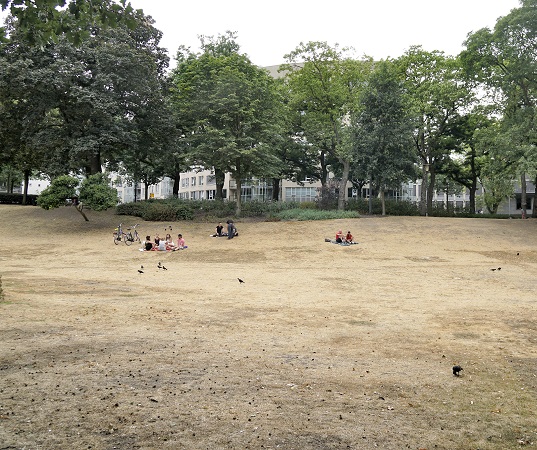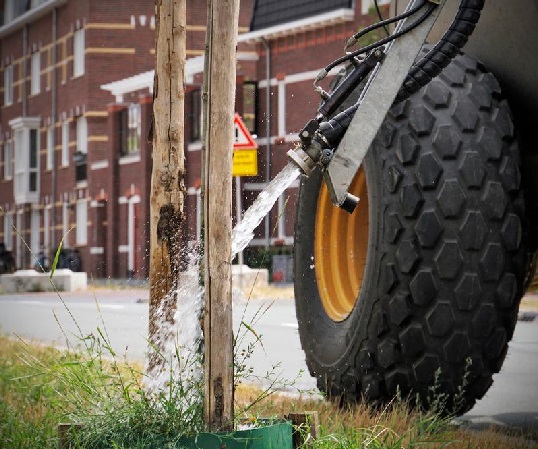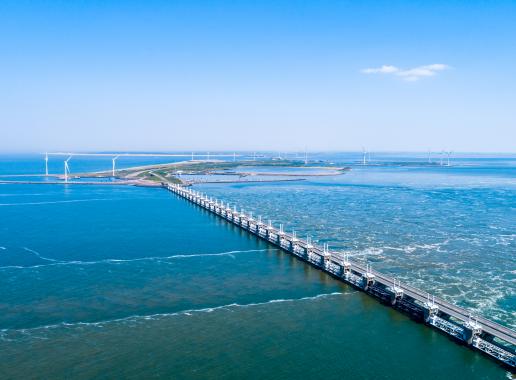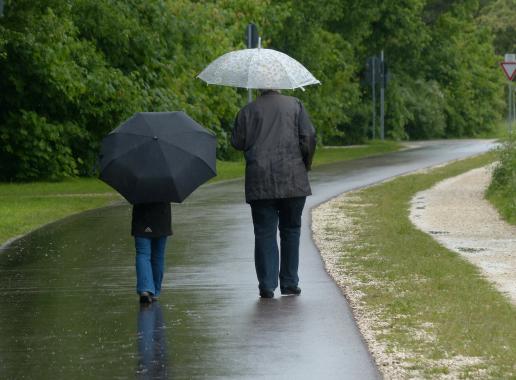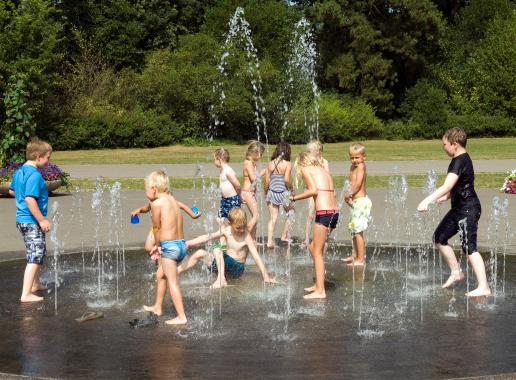Foto Wat is droogte
Wat is droogte?
We spreken van droogte wanneer er minder water beschikbaar is dan normaal; er kan dan een watertekort ontstaan. Droogte ontstaat als er minder regen valt dan normaal, als er meer water verdampt dan gebruikelijk, of beide. In Nederland valt er in de herfst en winter meer neerslag dan er water verdampt, we hebben dan te maken met een te veel aan water, een neerslagoverschot. Alleen in de lente en zomer is dit andersom, waardoor een neerslagtekort, ofwel droogte ontstaat.
Niet alleen het weer en het klimaat zijn van invloed op droogte. Ook de vraag naar water voor landbouw, drinkwater en industrie, de aanvoer van water via rivieren en het waterbeheer spelen een rol. Er is een watertekort als er minder water is dan nodig. Bijvoorbeeld als er in Nederland weinig regen valt en er ook weinig water via de Rijn en Maas ons land binnenkomt.
Droogte veroorzaakt problemen voor de veiligheid (verzwakte dijken), landbouw, binnenvaart, woonomgeving, waterkwaliteit en natuur. Vooral langdurige en langjarige droogtes geven problemen, zoals in 2018, 2019, 2020 en 2022. In Nederland zijn er afspraken over de waterverdeling bij droogte. Het weinige zoete water uit de grote rivieren en meren wordt dan zo goed mogelijk onder alle watergebruikers verdeeld via stuwen, pompgemalen en sluizen.
foto droogte
Will it get drier and where?
The Netherlands regularly experiences dry periods. The temperature is rising due to climate change and therefore more water is evaporating. An extra amount of water evaporates during sunny and warm weather. We also use a lot of water. We need water to drink, shower, cook and wash. But agriculture and livestock farming also use a lot of water for producing vegetables, fruit and meat.
Where has it become drier? At the coast, the amount of rainfall has increased between April and September. Inland, the amount of rain has remained the same or decreased. The drought problems are therefore greater for certain parts of the Netherlands.
foto
What are the dangers of drought?
Peat dikes can collapse during drought There is then a risk of flooding for residents behind the dike. Dike inspectors check for cracks more often or keep dikes wet to prevent cracks. Groundwater levels drop due to drought. Peat soils dry out. This causes the peat to rot (oxidise), a lot of CO2 is released and the ground subsides.
There is a greater risk of wildfires when forests become drier due to high levels of evaporation. To extinguish wildfires, it is important that there is sufficient water in ponds and lakes. The recovery of a nature reserve after a fire takes years. We need forests and heathland for biodiversity and leisure.
Wooden foundation poles of houses fall dry Poles rise above the groundwater when it is too dry. The wood of the poles then comes into contact with oxygen. The poles then become mouldy and rot (pole rot). This causes homeowners a lot of stress, because the repair costs are very high.
Foto
Drought and your health
In coastal areas, drought can cause the ground to become saltier due to seawater intrusion. Anticipate this by growing plants and crops that tolerate saline soil. Sea kale, glasswort and some varieties of potato also grow on saline soil. It is still unclear whether the Netherlands as a whole will on average become drier in the future.
Fresh water becomes scarce in the summer. It is especially in this period that the demand for water is high for agriculture, cooling water, swimming water and drinking water. When there is too little rain, extra groundwater or surface water is pumped up. This results in both local drought, which can blow away fertile soil, and in poor water quality.
In addition, in some parts inland, less water can be supplied from rivers. Supply from rivers is important to maintain the groundwater level and thus prevent drought. This is especially important next to the rivers. A low river level also creates problems for inland shipping.
foto
What can I do against drought?
- Especially in dry weather, people with lung problems are more affected by strong air pollutants such as car traffic, wood-burning stoves, barbecues and fireplaces. Keep this in mind and pay attention to the stookalert (wood burning warning system).
- Waste in natural areas can cause a wildfire (think of glass reflection in dry grass). Therefore, always dispose of your waste in a rubbish bin. No bins available? Take it home and throw it away. Smouldering material, such as a cigarette butt or a barbecue in the forest, is also dangerous for nature and forbidden during drought.
- By collecting rainwater, either underground or in a rain barrel, you create a water reserve. In times of drought, you can use this to keep your garden beautiful and healthy without having to use a lot of drinking water.
- Many plants can withstand a little drought. Keep this in mind when buying plants. This way, you do not have to water your plants every day in summer. If you do water, do it early in the morning or late in the evening.
- Keep an eye on the news for the heat plan, heating alerts and emergency weather codes after or during periods of drought.
foto droogte
Drought policy
To reduce the impact of droughts, the government is taking measures. The measures are to retain water, transport water and use less water. In dry periods, the water managers supply fresh water, from rivers and from the IJsselmeer. The Ministry of Infrastructure and Water Management, the water boards and the provinces jointly determine where the limited available water goes.
Greenery covers the soil against drying out and retains moisture. In built-up areas, the government provides more (small) parks and green areas. In this way, rainwater can sink into the ground instead of flowing into the sewers. And the soil will build up a reserve for dry periods.
Delta Programme Freshwater The government expects more frequent problems with drought in the future. The demand for freshwater is likely to increase and the climate is changing. The government has drawn up a Delta Decision on Freshwater as part of the Delta Programme. This provides more clarity on the availability of water.
Interesting websites (in Dutch)
Also check out these pages


